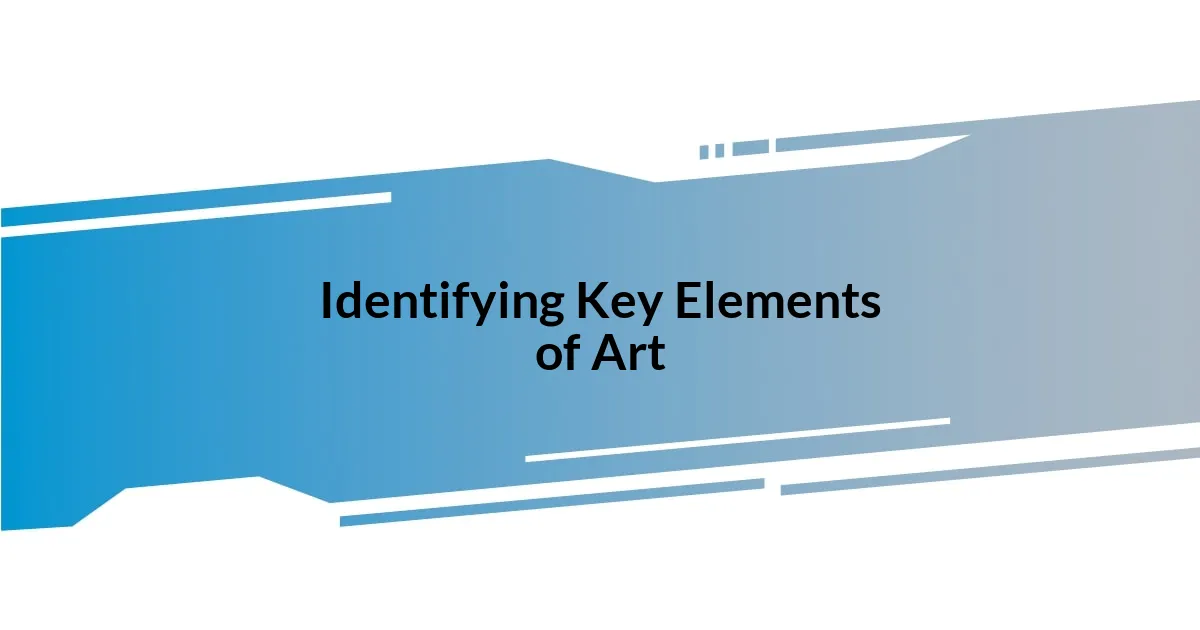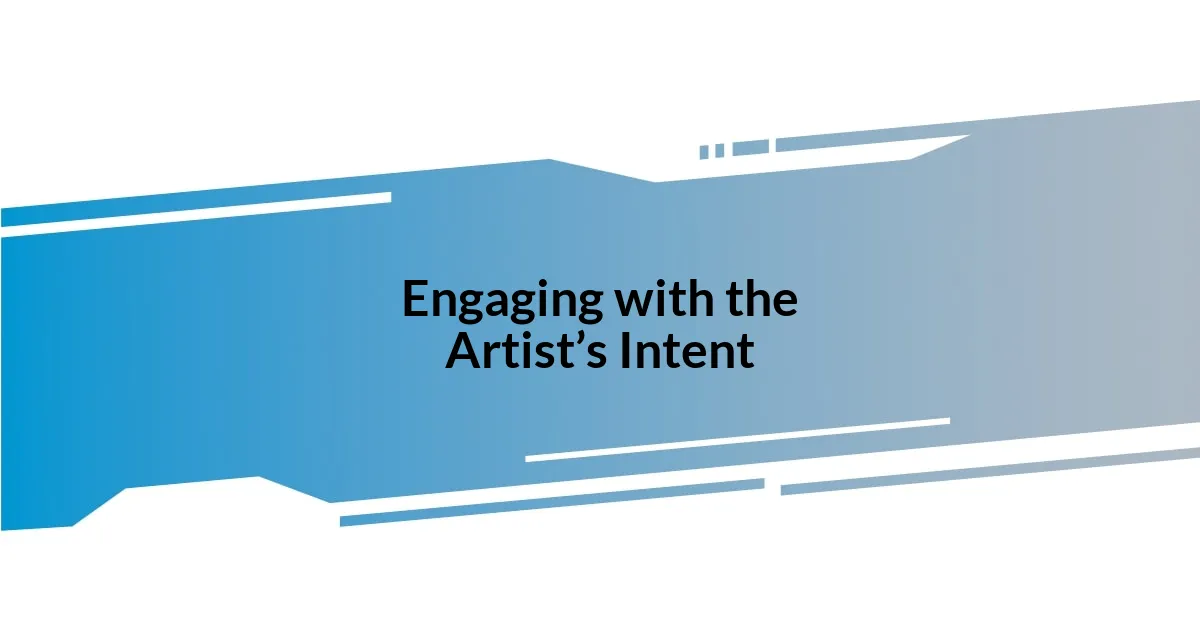Key takeaways:
- The art critique process emphasizes discovery through observation, interpretation, and respectful dialogue, fostering a deeper connection with the artwork.
- Identifying key elements such as line, color, and context enhances understanding and appreciation while allowing for personal interpretations shaped by individual experiences.
- Engaging in group critiques cultivates a supportive community that encourages honest feedback, diverse perspectives, and personal growth in the artistic journey.

Understanding Art Critique Process
When diving into the art critique process, I find it essential to remind myself that it’s not just about judgment but also about discovery. Every time I critique a piece, I feel like I’m peeling back layers of meaning, searching for what the artist intended to express. Have you ever looked at a painting and felt an immediate connection, only to be puzzled by its deeper themes? Those moments inspire me to dig deeper.
The critique process involves several stages: observation, interpretation, and evaluation. I remember a time when I was reviewing a friend’s artwork. Initially, I merely noted the colors and composition, but as I spent more time with it, I began to see the emotional tension in the brush strokes and the storytelling in the forms. This shift from surface-level observation to a richer interpretation is what makes art critique so engaging.
Ultimately, it’s about fostering a dialogue that respects the artist’s vision while encouraging honest feedback. When I approach critiques with curiosity, I feel like I’m participating in a shared journey rather than merely passing judgment. It’s not just about what I see but about how I connect with the artwork on a personal level—how does it resonate with my experiences and emotions?

Identifying Key Elements of Art
Identifying key elements of art transforms the way I experience and communicate about a piece. When I first approach a new artwork, I often find myself focusing on aspects like line, shape, color, and texture. For instance, I vividly recall critiquing a bold abstract painting where the jagged lines and vibrant hues invoked a sense of chaos. This experience taught me how powerful these elements can be when interpreting an artist’s intent.
While observing art, I also pay close attention to composition and form—how all these elements are arranged to convey a message. There was a moment during an exhibition when I stood in front of a serene landscape painting. I was drawn to the harmonious balance between the sky and land, which heightened the sense of tranquility. It reminded me that every detail serves a purpose and contributes to the overall narrative of the artwork.
Finally, understanding the context in which the art was created allows me to appreciate it on a deeper level. I remember reading about an artist’s struggle during the creation of a particular series. Knowing the backstory enriched my critique by revealing how personal experiences can shape artistic expression. It encouraged me to consider not just what I see, but the journey that led to the creation of the piece.
| Element | Importance |
|---|---|
| Line | Defines shape, guides the eye |
| Color | Evokes emotion, establishes mood |
| Texture | Adds depth, engages senses |
| Composition | Arranges elements for balance |
| Context | Informs meaning and intention |

Engaging with the Artist’s Intent
When I engage with an artist’s intent, I often recall a particularly evocative installation I encountered at a local gallery. The artist had used discarded materials to craft a poignant statement about consumerism and waste. It struck me how each piece was a reflection of their personal experiences and motivations. By understanding the intention behind the work, I felt a deeper emotional connection and saw the artwork as more than just a visual experience—rather, it became a narrative filled with hope and melancholy.
- Look for interviews or statements from the artist to gain insight into their thought process.
- Reflect on what emotions or thoughts the artwork evokes in you personally.
- Consider the historical or social context that may have influenced the artist’s choices.
- Analyze how the elements of the piece—like color and form—support the artist’s vision.
- Engage in discussions with others about their interpretation of the work for a broader perspective.
In my experience, connecting with an artist’s intent doesn’t just enhance my appreciation; it often leads to an enriching dialogue. For instance, during a critique session, I once shared my observations on an artist’s use of stark contrasts in a series of portraits. This elicited a passionate response from the artist, who explained that their goal was to highlight the inner struggle of identity. Moments like these remind me that each dialogue brings us closer to understanding the layers of meaning woven into the artwork, ultimately making the critique process so rewarding.

Using Constructive Feedback Techniques
Using constructive feedback techniques is essential in art critique, and I’ve found that framing my comments positively can lead to more productive conversations. For example, I once participated in a group critique where instead of saying, “This part doesn’t work,” I suggested, “Have you thought about exploring different color combinations here?” This subtle shift not only opened the door for discussion but also encouraged the artist to feel more confident about their work. Isn’t it amazing how a simple rephrasing can change the entire tone of a feedback session?
When I give feedback, I also try to balance my observations with something the artist is doing well. I clearly remember critiquing a friend’s installation where I loved the way they used space, but I felt the lighting could be adjusted. I started by praising the spatial arrangement for its magnetic quality, then transitioned to my lighting suggestion. This technique made it easier for my friend to hear the constructive part without feeling disheartened. Has this ever happened to you? Balancing critique with encouragement can create a supportive atmosphere that fosters growth.
Lastly, I always aim to ask open-ended questions to stimulate the artist’s reflection. During a critique, I once posed the question, “What feelings do you hope to evoke with this piece?” This not only helped the artist articulate their vision but also deepened my understanding of their work. I’ve noticed that questions often lead to meaningful discussions that enhance my own artistic perspective. Isn’t it fascinating how engaging in thoughtful dialogue can enrich both the critic’s and the artist’s experience?

Applying Personal Interpretation Skills
Applying personal interpretation skills in art critique allows me to truly connect with the artwork on a deeper level. I remember attending an exhibition where a painting depicted a vibrant sunset over a desolate landscape. At first glance, it seemed purely beautiful, but upon reflection, it evoked in me a tension between hope and despair. This duality sparked questions: Was the artist commenting on nature’s resilience amidst human neglect? Engaging with such interpretations enriches both my understanding and appreciation of the piece.
As I develop my interpretation skills, I also focus on how my own life experiences shape my viewpoints. For instance, while critiquing a series of abstract sculptures, I found myself reflecting on my journey through change and uncertainty. The irregular shapes and bold colors resonated with my struggles, making me realize that my personal context informs my critique. Isn’t it interesting how our backgrounds influence our interpretations? This realization encourages me to embrace those emotions and share them in the critique, revealing layers that may not be initially visible to others.
Lastly, I make it a habit to challenge my interpretations by discussing them with peers. I recall a time when I shared my thoughts about a series of photos capturing urban isolation, only to discover another perspective that highlighted community instead. Engaging in these exchanges forces me to confront my biases and expand my understanding. It’s remarkable how much richer my interpretation becomes through collaborative dialogue. How often do you reflect on the diverse perspectives of others when critiquing art? This shared exploration not only elevates the critique process but enhances my artistic journey too.

Practicing Art Critique in Groups
Gathering in groups for art critique can be a transformative experience, especially when everyone approaches it with openness and respect. I remember joining a small group that decided to critique each other’s sketchbooks. Initially, there was a bit of hesitation, but as we dove in, the shared vulnerability allowed us to express our thoughts freely. There’s something about critiquing in a supportive environment that encourages honest conversation. Have you ever felt that shift from anxiety to excitement in a group setting?
I also find that practicing critique in groups brings diverse perspectives that can enrich my understanding of the artwork. During one session, a fellow artist pointed out a technique I hadn’t considered while analyzing a mixed-media piece—how layering textures influenced the viewer’s emotional response. That insight truly opened my eyes! Isn’t it fascinating how just one person’s perspective can completely alter our approach to understanding art?
Moreover, I enjoy the element of community that comes with group critiques. One time, after sharing my own work that I felt was incomplete and raw, the collective enthusiasm in the room sparked a creative fire within me. It was as if their excitement ignited my passion and pushed me to explore my own ideas further. Can you recall a moment when community feedback propelled you to create something unexpected? In those moments, the group becomes a catalyst for growth, and it’s a powerful reminder of the synergy that creativity can foster.

Reflecting on the Critique Experience
Reflecting on the critique experience often leads me to unexpected revelations about my own artistic journey. I remember a moment during a critique session when a colleague pointed out how my choice of color schemes seemed to mirror my emotional state at that time. This wasn’t something I had consciously intended, but it made me think: how much of my art is a manifestation of my feelings? It’s those moments of insight that truly deepen my understanding of my own work.
I also find it valuable to revisit previous critiques, as they reveal my growth over time. Once, I looked back at comments on an early piece where I struggled with composition. Reading my peers’ feedback made me realize how far I’ve come in balancing elements in my work. Isn’t it empowering to witness your evolution as an artist through the lens of critique? This practice not only bolsters my confidence but also fuels my desire to keep pushing boundaries in future creations.
Ultimately, the most profound critiques often stir internal questions. After sharing a deeply personal piece, one that reflected my fears and insecurities, the feedback I received sparked a quest for self-discovery. My peers encouraged me to explore those feelings more openly. How often do we hide behind technique while our emotions yearn to be expressed? Each critique experience becomes a stepping stone, guiding me toward more authentic and fearless artistic expression.
